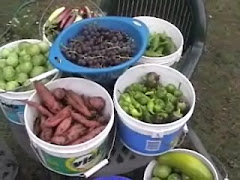
Looking down on their new relations the snobbish green asparagus was not at all pleased to be sharing its bed with a foreign visitor. "Who are these purple aberrations that have managed the winter and are now attempting to become permanent squatters, disrupting our all green society?" they demanded.

Looking up at their much larger rivals the peculiar purple asparagus respond "We are much sweeter and more tender then you, green asparagus. The farmer says we may stay as long as our performance holds up."

The green ones scowl and make preparation for a most bountiful harvest, "We will show the farmer who is best, we may not be as tasty but are far more productive" they tell each other.
The purple asparagus responds in kind, focusing it's energy on delicate flavor rather than quantity.

The farmer smiles, having overheard the argument, and thinks to himself "Just wait until I introduce the spargel" (white asparagus).

Looking up at their much larger rivals the peculiar purple asparagus respond "We are much sweeter and more tender then you, green asparagus. The farmer says we may stay as long as our performance holds up."

The green ones scowl and make preparation for a most bountiful harvest, "We will show the farmer who is best, we may not be as tasty but are far more productive" they tell each other.
The purple asparagus responds in kind, focusing it's energy on delicate flavor rather than quantity.

The farmer smiles, having overheard the argument, and thinks to himself "Just wait until I introduce the spargel" (white asparagus).



 .
. 

 The above also applies to the various forms of chicory we grow in our gardens.
The above also applies to the various forms of chicory we grow in our gardens.





 and chervil.
and chervil.









 Others just need to be re-potted...tomatillos, ground cherries
Others just need to be re-potted...tomatillos, ground cherries










































